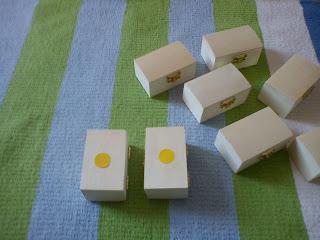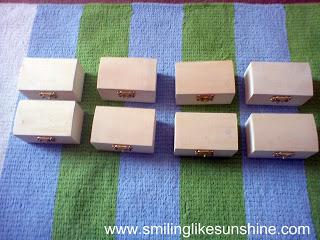
A couple of weeks ago I prepared these treasure boxes.
As you may know, sensorial activities are very important in the Montessori philosophy. Exploring the weight by the sense of touch is called the baric sense. In a Montessori classroom, children are supplied with baric tablets to develop and refine their baric senses.
A blindfold (optional) A mat 4 sets of wooden chests, filled with pebbles and bubble wrap to ensure the pebbles do not make any sound. Each set consists of two chests. Each of the wooden chests is plain and the same color. To mark the same weight chests, stickers are used. The weight of the sets is as follows: The lightest set is empty, each chest is 40gr, colour coded with a green sticker, The second set consists of chests each measuring 72gr, colour coded with yellow stickers, The third set consists of chests each measuring 104gr, colour coded with orange stickers, The heaviest set consists of chests each measuring 136gr, color coded with blue stickers. The difference between each set is 32gr.
Direct objective: Developing and refining the baric sense so that small differences in weight can be differentiated by the child. Indirect objective: · Becoming a good observer · Gaining a perception of weight, · Gaining awareness in differentiating the differences between weights · Developing the language: At the end of the activity the child will have learnt the words: heavy, heavier, heaviest, light, lighter, lightest, as heavy/light as Advance preparation for the lesson: Before starting the activity both the teacher and the student wash their hands as this helps sensitise the fingers.
PRESENTATION:
1. The teacher brings the materials to the rug. The teacher and the child sit opposite each other. 2. The teacher then takes out the lightest and the heaviest chests. 3. S/he puts the chests on his/her hands: palm up, arms relaxed. 4. The teacher shows the child how to weigh the chests, by moving both hands, with palm facing outward in an up down motion. The teacher moves her arms up and down slightly, to perceive the differences in weight. 5. S/he places them on the mat and invites the child to feel the weights of the chests 6. S/he puts the chests on the child’s finger tips, and then asks “Which one is lighter?” “Which one is heavier?” The teacher removes the chests and puts them on the mat 7. Carrying on with different chests, the teacher asks the child if they are heavy, light or are the same. The teacher continues removing the chests and putting them on the mat next to previously used chests as the child answers the questions. 8. When all chests are done,the teacher starts the activity again. This time s/he asks the child “Can you give me the heavier chest?” “Can you give me the lighter chest?” repeating until all chests are estimated. 9. The child takes off the blindfold and the teacher explains what has been done. Differentiation: If the child does not feel secure and does not want to use the blindfold, s/he can do the activity by averting his/her eyes. Older children can use a scale to check if they have sorted the chests correctly. As a control of error element, I added stickers on the bottom of the chests.
Never miss a post again! Sign up to receive all posts direct to your inbox. Enter your email address:
Delivered by FeedBurner

